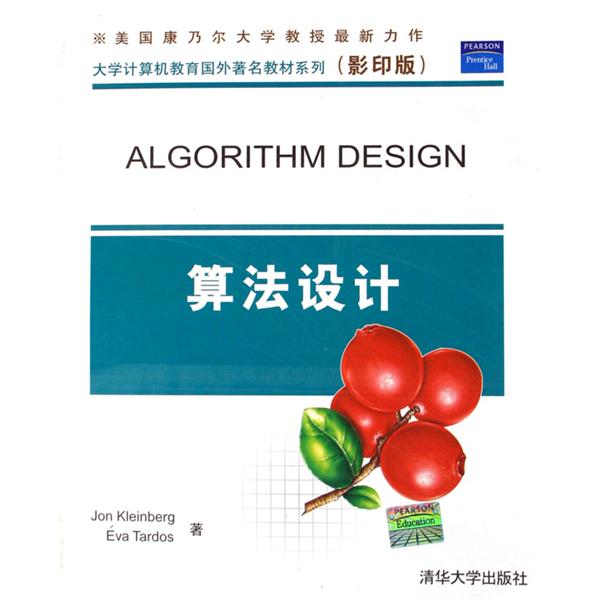《大學計算機教育國外著名教材系列·算法設計》是2006年由清華大學出版社出版的圖書,作者是(美)克萊因伯格 塔多斯
基本介紹
- 書名:大學計算機教育國外著名教材系列·算法設計
- ISBN:7302122601
- 頁數:838頁
- 出版社:清華大學出版社
圖書信息,作者簡介,內容簡介,目錄,
圖書信息
出版社: 清華大學出版社; 第1版 (2006年1月1日)
平裝: 838頁
開本: 16開
ISBN: 7302122601
條形碼: 9787302122609
尺寸: 23 x 18.5 x 3.6 cm
重量: 1.2 Kg
作者簡介
作者:(美)克萊因伯格 塔多斯
Jon Kleinberg is a professor of Computer Science at Cornell University. He received his Ph.D. from M.I.T. in 1996. He is the recipient of an NSF Career Award, an ONR Young Investigator Award, an IBM Outstanding Innovation Award, the National Academy of Sciences Award for Initiatives in Research, research fellowships from the Packard and Sloan Foundations, and teaching awards from the Cornell Engineering College and Computer Science Department.
Kleinberg's research is centered around algorithms, particularly those concerned with the structure of networks and information, and with applications to information science, optimization, data mining, and computational biology. His work on network analysis using hubs and authorities helped form the foundation for the current generation of Intern
內容簡介
《算法設計》(影印版)是近年來關於算法設計和分析的不可多得的優秀教材。《算法設計》(影印版)圍繞算法設計技術組織素材,對每種算法技術選擇了多個典型範例進行分析。《算法設計》(影印版)將直觀性與嚴謹性完美地結合起來。每章從實際問題出發,經過具體、深入、細緻的分析,自然且富有啟發性地引出相應的算法設計思想,並對算法的正確性、複雜性進行恰當的分析、論證。《算法設計》(影印版)覆蓋的面較寬,凡屬串列算法的經典論題都有涉及,並且論述深入有新意。全書共200多道豐富而精彩的習題是《算法設計》(影印版)的重要組成部分,也是《算法設計》(影印版)的突出特色之一。
目錄
About the Authors
Preface
Introduction: Some Representative Problems
1.1 A First Problem: Stable Matching
1.2 Five Representative Problems
Solved Exercises
Exercises
Notes and Further Reading
Basics of Algorithm Ana/ys/s
2.1 Computational Tractability
2.2 Asymptotic Order of Growth
2.3 Implementing the Stable Matching Algorithm Using Lists and Arrays
2.4 A Survey of Common Running Times
2.5 A More Complex Data Structure: Priority Queues
Solved Exercises
Exercises
Notes and Further Reading
3 Graphs
3.1 Basic Definitions and Applications
3.2 Graph Connectivity and Graph Traversal
3.3 Implementing Graph Traversal Using Queues and Stacks
3.4 Testing Bipaniteness: An Application of Breadth-First Search
3.5 Connectivity in Directed Graphs
3.6 Directed Acyclic Graphs and Topological Ordering
Solved Exercises
Exercises
Notes and Further Reading
4 Greedy Algorithms
4.1 Interval Scheduling: The Greedy Algorithm Stays Ahead
4.2 Scheduling to Minimize Lateness: An Exchange Argument
4.3 Optimal Caching: A More Complex Exchange Argument
4.4 Shortest Paths in a Graph
4.5 The Minimum Spanning Tree Problem
4.6 Implementing Kruskal's Algorithm: The Union-Find Data Structure
4.7 Clustering
4.8 Huffman Codes and Data Compression
* 4.9 Minimum-Cost Arborescences: A Multi-Phase Greedy Algorithm
Solved Exercises
Exercises
Notes and Further Reading
5 D/v/de and Corn/net
5.1 A First Recurrence: The Mergesort Algorithm
5.2 Further Recurrence Relations
5.3 Counting Inversions
5.4 Finding the Closest Pair of Points
5.5 Integer Multiplication
5.6 Convolutions and the Fast Fourier Transform
Solved Exercises
Exercises
Notes and Further Reading
6 Dynamic Programming
6.1 Weighted Interval Scheduling: A Recursive Procedure
6.2 Principles of Dynamic Programming: Memoization or Iteration over Subproblems
6.3 Segmented Least Squares: Multi-way Choices
6.4 Subset Sums and Knapsacks: Adding a Variable
6.5 RNA Secondary Structure: Dynamic Programming over Intervals
6.6 Sequence Alignment
6.7 Sequence Alignment in Linear Space via Divide and Conquer
6.8 Shortest Paths in a Graph
6.9 Shortest Paths and Distance Vector Protocols
* 6.10 Negative Cycles in a Graph
Solved Exercises
Exercises
Notes and Further Reading
Network Flora
7.1 The Maximum-Flow Problem and the Ford-Fulkerson Algorithm
7.2 Maximum Flows and Minimum Cuts in a Network
7.3 Choosing Good Augmenting Paths
* 7.4 The Preflow-Push Maximum-Flow Algorithm
7.5 A First Application: The Bipartite Matching Problem
7.6 Disjoint Paths in Directed and Undirected Graphs
7.7 Extensions to the Maximum-Flow Problem
7.8 Survey Design
7.9 Airline Scheduling
7.10 Image Segmentation
7.11 Project Selection
7.12 Baseball Elimination
* 7.1.3 A Further Direction: Adding Costs to the Matching Problem Solved Exercises
Exercises
Notes and Further Reading
NP and Computational Intractability
8.1 Polynomial-Time Reductions
8.2 Reductions via "Gadgets": The Safisfiability Problem
8.3 Efficient Certification and the Definition of NP
8.4 NP-Complete Problems
8.5 Sequencing Problems
8.6 Partitioning Problems
8.7 Graph Coloring
8.8 Numerical Problems
8.9 Co-NP and the Asymmetry of NP
8.10 A Partial Taxonomy of Hard Problems
Solved Exercises
Exercises
Notes and Further Reading
9 PSPACE: A Class of Problems beyond NP
9.1 PSPACE
9.2 Some Hard Problems in PSPACE
9.3 Solving Quantified Problems and Games in Polynomial Space
9.4 Solving the Planning Problem in Polynomial Space
9.5 Proving Problems PSPACE-Complete
Solved Exercises
Exercises
Notes and Further Reading
10 Extending the Limits of Tractability
10.1 Finding Small Vertex Covers
10.2 Solving NP-Hard Problems on Trees
10.3 Coloring a Set of Circular Arcs
* 10.4 Tree Decompositions of Graphs
* 10.5 Constructing a Tree Decomposition
Solved Exercises
Exercises
Notes and Further Reading
11 Approximation Algorithms
11.1 Greedy Algorithms and Bounds on the Optimum: A Load Balancing Problem
11.2 The Center Selection Problem
11.3 Set Cover: A General Greedy Heuristic
11.4 The Pricing Method: Vertex Cover
11.5 Maximization via the Pricing Method: The Disjoint Paths Problem
11.6 Linear Programming and Rounding: An Application to Vertex Cover
* 11.7 Load Balancing Revisited: A More Advanced LP Application
11.8 Arbitrarily Good Approximations: The Knapsack Problem
Solved Exercises
Exercises
Notes and Further Reading
Local Search
12.1 The Landscape of an Optimization Problem
12.2 The Metropolis Algorithm and Simulated Annealing
12.3 An Application of Local Search to Hopfield Neural Networks
12.4 Maximum-Cut Approximation via Local Search
12.5 Choosing a Neighbor Relation
12.6 Classification via Local Search
12.7 Best-Response Dynamics and Nash Equilibria
Solved Exercises
Exercises
Notes and Further Reading
Randomized Algorithms
13.1 A First Application: Contention Resolution
13.2 Finding the Global Minimum Cut
13.3 Random Variables and Their Expectations
13.4 A Randomized Approximation Algorithm for MAX 3-SAT
13.5 Randomized Divide and Conquer: Median-Finding and Quicksort
13.6 Hashing: A Randomized Implementation of Dictionaries
13.7 Finding the Closest Pair of Points: A Randomized Approach
13.8 Randomized Caching
13.9 Chernoff Bounds
13.10 Load Balancing
13.11 Packet Routing
13.12 Background: Some Basic Probability Definitions
Solved Exercises
Exercises
Notes and Further Reading
Epilogue: Algorithms That Run Forever
References
Index

